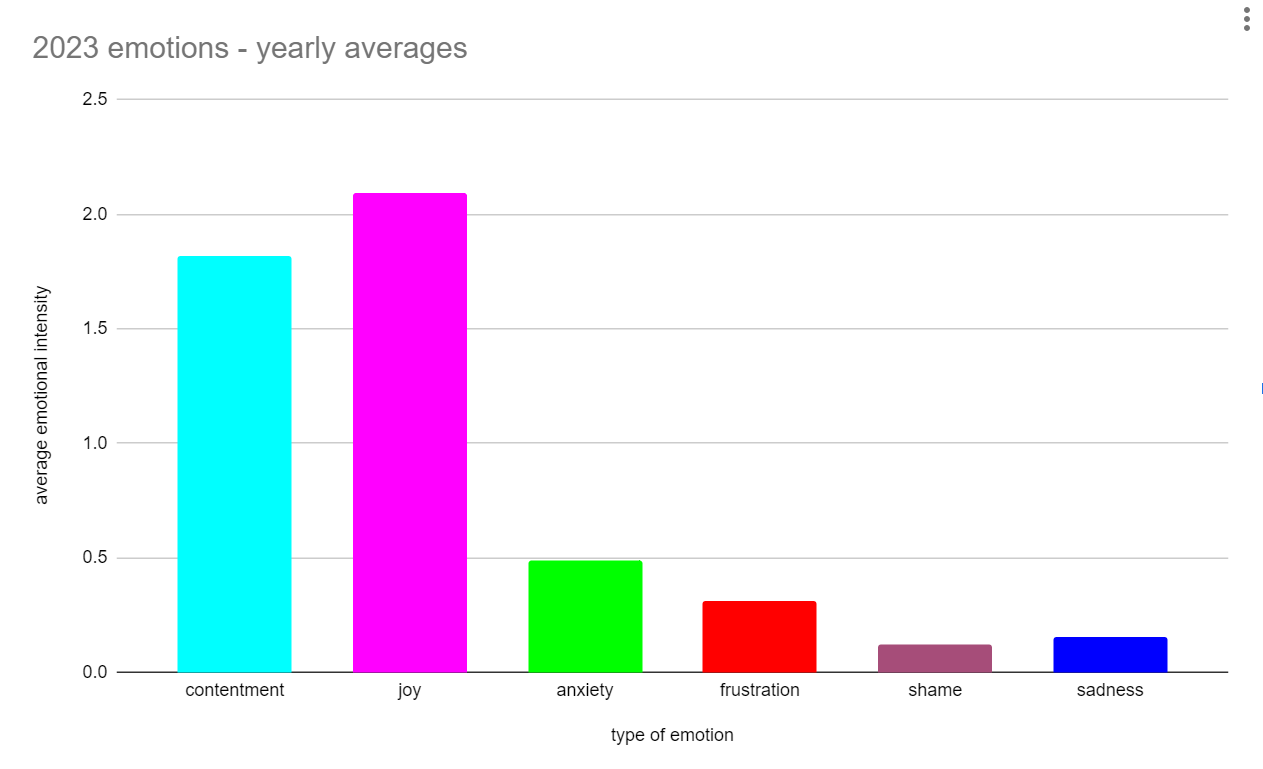Now that it’s 2024, I’ve reached an exciting milestone: my first full year of bullet journaling. There’s a lot that I’ve been trying to track with the bullet journal, and much of it has changed over the course of the year, but one of the things I’ve managed to stay consistent about is tracking my own emotions. I kept a simple log every day about my emotional experience, and now I have a year’s worth of data, which I’d like to examine and see if I can learn anything interesting about myself or the past year.
I’ll start by explaining my system. I decided on six emotional metrics to track every day: contentment, joy, anxiety, frustration, sadness, and shame—two positive categories, and four (mostly) negative ones. I used these categories pretty flexibly, meaning that the specifics of the emotion or its particular causes were totally irrelevant. If it registered enough for me to notice, it factored into the metric for that day. This made it a lot easier, I think, to keep a daily practice of reflecting on how I felt.
For similar reasons, I limited the amount/intensity of each emotion to a scale from 0 to 3. 0 meaning basically none, 1 meaning some, 2 meaning a moderate amount, and 3 meaning a lot. I hoped that both of these restrictions would make it easy to pick a number that seemed accurate quickly, and I think that worked.
In the last few days, I compiled all the data together in a spreadsheet, and ran some simple calculations. First, I charted the ebbs and flows of my average emotions per month, over the course of the year.
This chart showcases some insights about how my circumstances changed during the year; predictably so, but interesting to see nevertheless. For example, both my reported contentment and joy seem to peak during the summer, dip in the fall when I moved to a whole new state, and have started trending upward since getting a bit settled. Similarly, I can distinctly remember the events that caused some of the small spikes in negative emotions—like the anxiety in March and the frustration in June.
But the most standout conclusion from this data, in my opinion, is one that can be even more simplified, by just charting the total average for each emotion for the entire year.
In both cases, it seems obvious that my average reported level of contentment and joy were significantly higher than the average of the other, negative emotions. In fact, my average reported contentment and joy were both right around 2, while my negative emotions all averaged less than 0.5.
And it makes sense, because on a typical day where nothing especially notable happened, I would often report moderate contentment, moderate joy, and not enough of the negative emotions to register above zero. But it’s still striking to look at the data and see that, in the context of the whole year, days where I felt extremely anxious or extremely frustrated still only really register as a drop in the bucket of an otherwise pleasantly non-turbulent emotional experience.
In some ways, this is hard for me to swallow. Especially having just moved, it feels like 2023 was a year of huge change, filled with ups and downs and plenty of uncertainty about the future. Part of me—maybe a part with a tendency to self-victimize a little bit—wants to claim that the past year is primarily characterized by those ups and downs, and that, especially in the last few months, I experienced fleeting pockets of respite in between a mostly tumultuous experience. But, well… the data says otherwise. Realistically speaking, the opposite is much more true.
I picked the graph for the cover photo on this post mostly because I thought it looked silly and convoluted, and therefore evokes how absurd it is to make near-trivially simple numerical data out of my own subjective emotional experience. But I also picked it because it sort of demonstrates my point anyways: the instances of anxiety, frustration, shame, and sadness are part of the picture, yet are only streaks of color in an ocean of light blue and bright pink—the colors I chose to represent contentment and joy—even during the times that felt the least stable.
And I think I know how this might have happened. The habit of sitting and reflecting on how content and how joyful I was that day essentially amounts to a gratitude practice. It turns out that dwelling on the positives in your life makes it easier to appreciate the positives in your life. Who knew? You might think that the same would be true of the negative emotions, too, like if you stew on the things that sucked that day, it’ll make them seem worse. But for whatever reason, it didn’t happen like that. Somehow, the positive emotions managed to eclipse the negative ones, most of the time.
Here’s the crazy part, though. If you told me I could choose my entire emotional experience ahead of time, for the entire year, with the option to completely forgo the negative emotions… I don’t think I would do that. As much as they might suck, anxiety and frustration and shame and sadness are all part of a very human spectrum of emotion, and I don’t think it would be worth it to miss them entirely.
If I really did get to choose, I think I would probably allot myself a tolerable amount of each of those negative emotions, and fill the rest of my life up with contentment and joy.
Fortunately, if next year is anything like last year, it might happen like that again anyway.

Phil Rienstra (they/he) (‘21) studied writing and music, and since graduating has developed a deep interest in labor rights. They currently work at a unionized Starbucks and volunteer with Starbucks Workers United. They’re an amateur chef, a perennial bandana wearer, and an Enneagram 4. He lives in St. Paul with his spouse, Heidi.




